The Meaning of Prayer Flags in the Himalayas
As you trek through the breathtaking landscapes of the Himalayas, you’ll notice vibrant prayer flags fluttering in the wind. These colourful flags, strung along mountain ridges, peaks, and sacred places, add a vibrant splash of colour to the often stark and rugged terrain.
But what do they signify? Beyond their aesthetic appeal, prayer flags are steeped in deep spiritual and cultural meaning. They are a living tradition that encapsulates the beliefs, hopes, and aspirations of the Himalayan people. This article will delve into the history and symbolism of prayer flags, uncovering the messages and blessings they carry across the vast mountain landscapes.
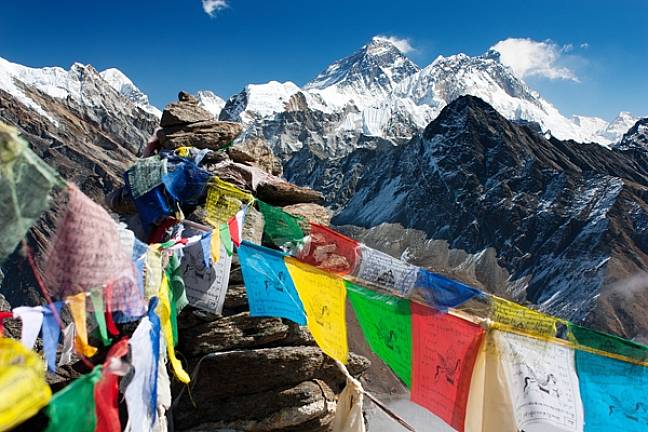

What are Prayer Flags?
Prayer flags are a significant cultural and religious symbol and are a common sight in the Himalayan region. These colourful flags, often seen fluttering on mountain passes, temples, and homes, carry deep spiritual meanings and are believed to promote peace, compassion, strength, and wisdom.
Origins
The origins of prayer flags trace back to ancient Tibet, where they were initially part of the indigenous Bön tradition. Shamans in this pre-Buddhist religion used plain flags in their healing ceremonies as the flags were believed to carry healing energies and protective powers.
Additionally, legends of the Buddha’s prayers were written on battle flags used by warring deities called devas and asuras. These flags symbolised divine intervention and protection in battles, combining spiritual significance with practical use.
Another theory suggests that the practice originated from the tradition of writing Indian Buddhist Sutras to the rest of the world on pieces of cloth to transmit sacred teachings, combining a spiritual purpose with the practical need to preserve and disseminate religious texts.
Buddhist Adoption
As Buddhism spread into Tibet around the 7th century, prayer flags were seamlessly integrated into Buddhist practices; the concept of inscribing sacred texts on flags aligned well with Buddhist values of compassion and wisdom. Monks began to inscribe mantras, prayers, and symbols on these flags, believing that the wind would carry these blessings to all beings.
The five colours of the flags represent the five elements, which are essential in Buddhist philosophy and will be explained further in this article. By adopting prayer flags, Buddhists created a tangible way to spread positive energy and prayers across the landscape.
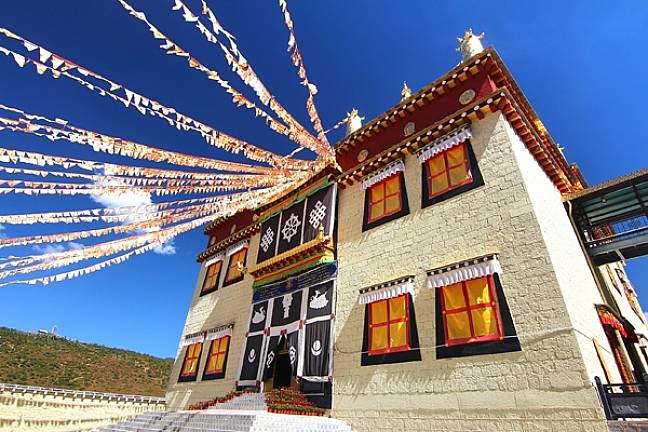

The Symbolism and Meaning of Prayer Flags
As we mentioned, prayer flags are not just colourful decorations; they are rich with symbolism and spiritual meaning, deeply rooted in Buddhist tradition and Himalayan culture. Let's delve into the significance of their colours, mantras, and symbols.
Prayer Flag Colours and Their Meanings
Prayer flags come in five specific colours, each representing an element, and they are always arranged in a specific order, reflecting their connection and the harmony they bring. The colours are traditionally woodblock-printed with images and texts. You’ll have plenty of opportunities to examine these in detail on your Everest Base Camp trek.
Blue: This colour represents the sky and space. It symbolises vastness, open-mindedness, and the infinite nature of the sky.
White: Symbolising air and wind, white flags are associated with purity, compassion, and the breath of life.
Red: Representing fire, red flags are linked to energy, passion, and transformation.
Green: Denoting water, green flags symbolise harmony, balance, and the nurturing qualities of water.
Yellow: This colour symbolises the earth, so yellow flags stand for stability, fertility, and the grounding aspects of life.
Prayer Flag Symbols and Icons
The images and symbols printed on prayer flags add extra layers of meaning. The centre of the flag often depicts a Lungta (wind horse), representing speed and the transformation of bad fortune into good. It often carries three jewels on its back, which symbolise the Buddha, the Dharma (Buddhist teachings), and the Sangha (Buddhist community).
There are usually images of four sacred animals in the corners of the prayer flag too:
Dragon: Symbolises strength and protection. Dragons are powerful, celestial beings that ward off evil and bring good fortune.
Garuda: Represents wisdom and the ability to see all things clearly. This mythical bird is known for its sharp vision and keen perception.
Tiger: Symbolises confidence and strength. Tigers are seen as guardians and protectors, instilling courage and power.
Snow Lion: Represents fearlessness and joy. This mythical creature embodies the qualities of happiness, free from fear.
Prayer Flag Mantras
After the colours and symbols, the rest of the prayer flag is covered with 400 or so mantras (powerful ritual utterances) and prayers for the life and fortune of the person tying the flag. One of the most common mantras found on prayer flags is “Om Mani Padme Hum”. It’s associated with Avalokiteshvara, the Bodhisattva of Compassion and each syllable of this mantra carries a deep spiritual meaning.
Om: Purifies the ego and the body.
Ma: Purifies jealousy and the speech.
Ni: Purifies passion and the mind.
Pad: Purifies ignorance and the condition.
Me: Purifies greed and the touch.
Hum: Purifies hatred and the spirit.
It is thought that when the wind blows through the flags, it carries the meaning of these mantras and positive energy across the land, promoting peace, compassion, and wisdom to all beings.
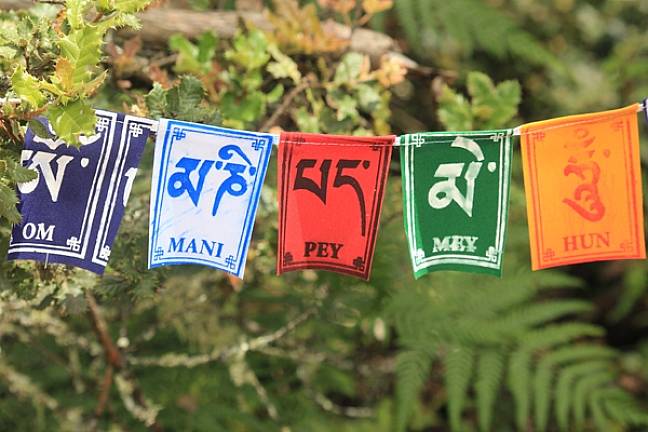

The Types of Prayer Flags & Their Placement
Prayer flags come in various forms, each with unique significance and use. Lungta (wind horse flags) and Darchor (vertical flags) are the two main types, and you will see them quite frequently throughout an Everest Base Camp Trek.
At Base Camp itself, the expedition tents are often bedecked with prayer flags by their Sherpa team members. You will also regularly find them marking high passes such as the Kang La in Nepal, at the top of summits such as Gokyo Ri or Kala Pattar - which is a small peak overlooking Base Camp, and tied to stupas and memorials along the chosen route.
Lungta
Lungta, or wind horse flags, are perhaps the most well-known type of prayer flags. When in the Himalayas, you’ll typically find them strung horizontally across mountain passes, between trees, on high poles or rooftops to name a few. They are placed in these locations so the wind can catch them easily, ensuring that the prayers are dispersed far and wide.
Darchor
Darchor flags are another type of prayer flag, distinct from the Lungta in that they are vertical, not horizontal. These tall, imposing flags serve a slightly different purpose and are used in varied settings. They often carry similar mantras and symbols as Lungta flags but are used to mark more specific sacred or significant locations as they are believed to provide stability and spiritual protection to the area they are placed in.
These flags are usually mounted on long poles and placed in the ground, often near monasteries, stupas, or important passes. As you trek to Everest Base Camp, you will find them at the Thyangboche Monastery – a Buddhist Monastery in the heart of the Khumbu where the annual Mani Rimdu Festival is held. Their vertical position makes them stand out, creating a powerful visual impact and a focal point for spiritual energy.
Materials and Construction
Prayer flags are traditionally made using simple yet durable materials, such as cotton or hemp, that withstand the harsh weather conditions of the Himalayas. These materials are chosen especially for their ability to hold the printed images and texts well. Modern flags might also use synthetic fabrics, but traditionalists prefer natural fibres for their spiritual purity.
The process of building prayer flags begins with woodblock printing. Craftsmen carve intricate designs, mantras, and symbols into wooden blocks. These blocks are then dipped in ink and pressed onto the fabric, transferring the sacred images and texts. Once printed, the flags are cut to size and attached to string or poles.
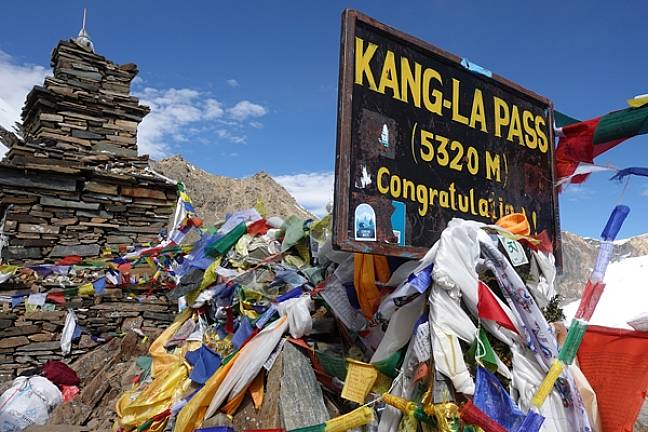

The Spiritual and Cultural Impact of Prayer Flags
As we’ve discovered, prayer flags are more than just colourful pieces of cloth fluttering in the wind. They hold deep spiritual and cultural significance that resonates both within the Himalayan communities and beyond. Their presence on an Everest Base Camp trek, for instance, offers a profound glimpse into their enduring impact.
Spiritual Significance
For many Himalayans, prayer flags are a vital part of spiritual life. They believe that when the wind blows the flags, it spreads the blessings, goodwill, and compassion embodied in the images and writings across the land. This act of spreading positive energy helps to purify the environment and bring harmony to all living beings.
Over time, the prints on the flags fade and the prayers become part of the universe, symbolising the fleetingness of life and the continual renewal of spiritual energy. As the old flags wear out, new ones are hung to continue the cycle of prayers and blessings.
For individuals, hanging prayer flags can be a deeply personal and reflective act. It’s a way to connect with the divine, seek protection, and offer prayers for themselves and others. This ritual creates a sense of peace, mindfulness, and spiritual connection.
Cultural Unity
In the diverse cultures of the Himalayas, prayer flags play a significant role in fostering cultural unity. Despite the varied ethnic and cultural backgrounds in the region, the practice of hanging prayer flags is usually embraced by Buddhists, Hindus, and even non-religious people in the area, surpassing local traditions.
Prayer flags are a symbol of cultural identity for the Himalayan people. They represent the collective heritage and spiritual resilience of the communities, serving as a reminder of their connection to the land and each other.
Global Influence
The influence of prayer flags has extended far beyond the Himalayas, resonating with people around the world. In the West, they are appreciated for their aesthetic appeal and spiritual symbolism, sometimes used in gardens, yoga studios, and as part of holistic health practices.
The global adoption of prayer flags reflects a broader cultural exchange. As people travel and learn about different traditions, they bring back practices like hanging prayer flags, which enrich their own cultural landscapes with these meaningful symbols.
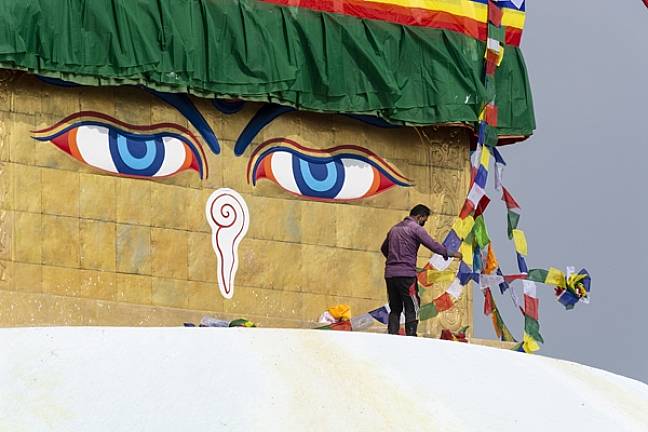

Summary
Prayer flags in the Himalayas are far more than just colourful decorations; they are a profound expression of spiritual and cultural heritage. These flags encapsulate centuries of tradition, carrying prayers, mantras, and symbols that spread blessings and positive energy across the land.
Whether you encounter them on a trek to Everest Base Camp or see them adorning a local shrine, understanding the meaning behind these vibrant flags enriches the experience. They serve as a testament to the enduring spiritual practices of the Himalayan people and their deep connection to the natural world. By appreciating the significance of prayer flags, we not only honour a beautiful tradition but also embrace the timeless values they represent.
If you’d like to experience the beauty and spirituality of prayer flags in person, Mountain Kingdoms offers a variety of Base Camp trips and treks in the Everest region. Our expert guides will be able to answer any questions you may have and explain the value and meaning of prayer flags on a personal level.
Whether you're a seasoned mountaineer or a novice trekker, there are plenty of options for you to explore. If you have any queries, Contact our friendly team who'll be very happy to answer your questions.

This blog was written with the contribution of Mountain Kingdoms MD and owner, Steve Berry. Originally called Himalayan Kingdoms, Steve set up the company in 1987, using the expertise and knowledge he had gained organising and leading expeditions in Nepal, Bhutan, Tibet and the Indian Himalaya for much of his adult life. Passionate about exploring the greatest mountains on the planet, Steve wanted to break from a conventional career and share the wonders of the Himalaya with others. Since then, the company has established itself as one of the foremost Himalayan tour operators in the UK with a portfolio of classic and pioneering treks as well as walking holidays and in-depth cultural tours. Steve has long been interested in the religious beliefs, traditions and myths that are so integral to the culture of the peoples of the Himalaya and you will always find a string of prayer flags hanging in the Mountain Kingdoms office in the Cotswolds.